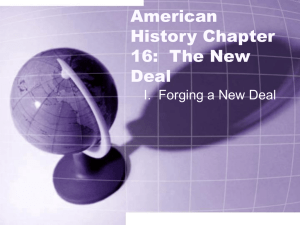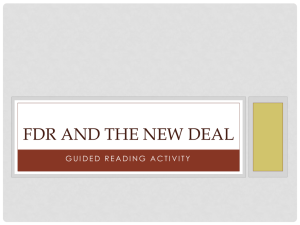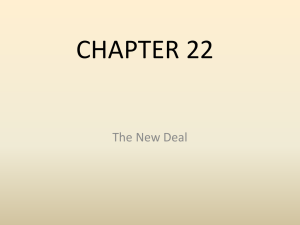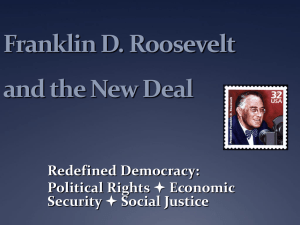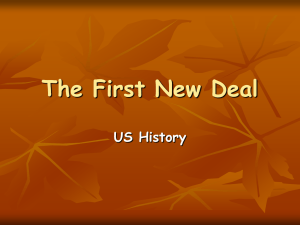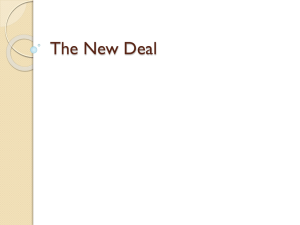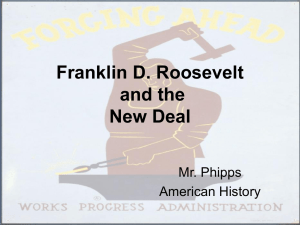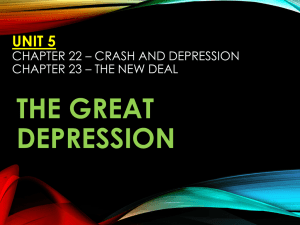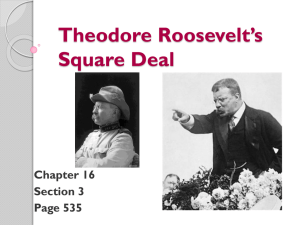The New Deal - Walton High
advertisement
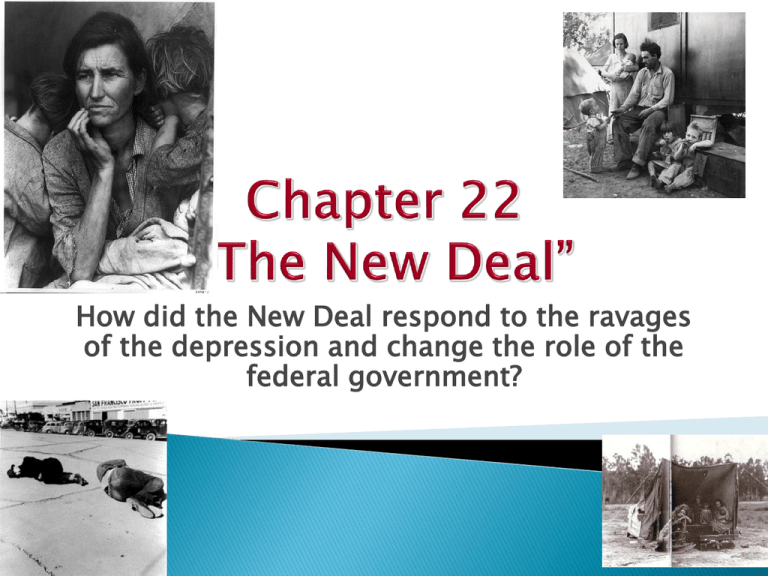
How did the New Deal respond to the ravages of the depression and change the role of the federal government? How did the New Deal attempt to address the problems of the depression? Vocabulary: -Franklin D. Roosevelt CCC -Eleanor Roosevelt NRA -New Deal PWA -fireside chat FDIC -Charles Coughlin TVA -Huey Long SSUSH18 The student will describe Franklin Roosevelt's New Deal as a response to the depression and compare the ways governmental programs aided those in need. Element: SSUSH18.a Describe the creation of the Tennessee Valley Authority as a works program and as an effort to control the environment. Element: SSUSH18.b Explain the Wagner Act and the rise of industrial unionism. Element: SSUSH18.c Explain the passage of the Social Security Act as a part of the second New Deal. Element: SSUSH18.d Identify Eleanor Roosevelt as a symbol of social progress and women's activism. Element: SSUSH18.e Identify the political challenges to Roosevelt's domestic and international leadership including the role of Huey Long, the "court packing bill," and the Neutrality Act. •FDR Offers Relief and Recovery Roosevelt Takes Charge Main Idea: Franklin D. Roosevelt rose in the political ranks in the early 1900s and was elected President in 1932 with the promise of a “New Deal” to fight the depression. The First Hundred Days Provide Instant Action Main Idea: Roosevelt quickly took action to reform financial institutions and provide relief to those in need. Opposition to the New Deal Emerges Main Idea: Opponents to Roosevelt’s policies grew from multiple political parties. The depression was the big issue in the election of 1932, Democrat, Franklin D. Roosevelt was elected. Hoover stood no chance because the economy was at its worst, but people figured a new president would have a greater chance of making changes FDR introduced many ideas for change but the depression did not end until the U.S. entered into WWII in 1941. •CHART •FDR Not Slowed by Polio Eleanor visited World War I vets who staged a second Bonus March, earning their respect FDR, in his Inaugural Address, said, “The only thing we have to fear is fear itself.” Toured country for FDR Lectured and wrote a newspaper column Gave press conferences for women correspondents The New Deal became FDR’s program of relief, recovery, and reform aimed at combating problems caused by the Depression. Not knowing how his program would work, FDR experimented and had the support of the American people. America’s response to the Great Depression proved that a democracy could overcome an economic crisis Relief measures were designed to stop suffering by: 1. providing direct money payments or jobs to the unemployed 2. providing mortgage loans to help farmers and homeowners in danger of losing their property Roosevelt wanted to bring about recovery by providing aid to farmers, business owners, and workers and by getting people back to work. The government provided many jobs for people by building roads, highways, public buildings, dams, and parks. The third R, reform, was intended less to help ease the Depression than to make sure there would never be another one. These measures regulated businesses and banks and protected bank depositors, investors, consumers, the aged, children, and the unemployed. •NOTE TAKING •Reading Skill: Connect Ideas Congress passed 15 bills, known as the First New Deal Emergency Banking Act passed by Congress -“bank holiday” – FDR ordered all banks to close for four days to inspect the bank’s financial health.. Federal Deposit Insurance Corporation (FDIC) insured deposits up to $5,000. FERA – Federal Emergency Relief Administration; agency to help local relief agencies by sending funds too be distributed. Public Works Programs (WPA)– government-funded projects to build public facilities such as roads, parks, airports, etc. Civilian Works Administration (CWA) gave jobs building roads, parks, airports. Civilian Conservation Corps (CCC) put 2.5 million young, unmarried men to work restoring forests, beaches, and parks. National Recovery Administration (NRA) tried to balance the unstable economy through planning. •TRANSPARENCY •Civilian Conservation Corps Public Works Administration (PWA) built projects like the Grand Coulee Dam in Washington. Securities and Exchange Commission (SEC) regulated the stock market. Home Owners’ Loan Corporation (HOLC) refinanced mortgages for homeowners. Agricultural Adjustment Administration (AAA) tried to raise farm prices through subsidies. Some farmers were paid not to crops. The Tennessee Valley Authority was created to help farmers and create jobs in The Tennessee Valley area. It provided cheap electric power, flood control, and recreational opportunities. •ANALYZE •Political Cartoons: The Galloping Snail Some thought the changes of the New Deal were too radical Some thought that the changes made the government too powerful American Liberty League – formed, saying FDR had deserted the principles of a limited government Women received lower wages, with men and boys receiving preference for jobs. African Americans were kept out of skilled jobs and received lower pay that whites for the same work. Since farmers and domestic workers were excluded by Social Security, 2/3 of them were not covered. Wealthy thought the New Deal did too much. Progressives and Socialists thought it did too little. Demagogues such as Father Charles E. Coughlin and Huey Long called for nationalization of banks and industry, and redistribution of wealth. Father Charles Coughlin Senator Huey Long •COMPARING VIEWPOINTS •The New Deal: Too Much — or Not Enough? •PM •TRANSPARENCY •Progress Monitoring Transparency What major issues did the second New Deal address? Vocabulary: -second New Deal -collective bargaining -John Maynard Keynes -pump priming -Social Security Act strikes -Fair Labor Standards Act WPA CIO Wagner Act court packing sit-down •The Second New Deal •Extending Social and Economic Reform •Main Idea: Roosevelt extended his reforms to provided longer lasting relief to those in need. •Labor Unions Find a New Energy •Main Idea: The New Deal passed laws recognizing labor unions and giving workers more rights. •Challenges to the New Deal •Main Idea: After a clash with the Supreme Court, Roosevelt lost some of his popularity • • •NOTE TAKING •Reading Skill: Connect Ideas After the Supreme Court declared the NIRA and AAA unconstitutional, FDR announced new agencies aimed at more social welfare, more control over business, stronger support for unions, and higher taxes on the rich. Works Progress Administration (WPA) provided work for 8 million citizens by building playgrounds, schools, hospitals, and airfields, as well as paying artists and writers. Resettlement Administration loaned money to owners of small farms and helped resettle tenants and sharecroppers; replaced by the Farm Security Administration (FSA) that loaned $1 million to farmers and set up camps for migrant workers. Social Security Act: established pension system for the elderly, unemployment insurance for workers who lost their jobs, aid for mothers and children, the blind and disabled. Rural Electrification Administration: loaned money to electric companies to build lines in rural areas Water Projects: Central Valley irrigation system; Bonneville Dam – helped develop the West •GRAPH •Farms With Electricity, 1930-1950 •GRAPH •Labor Union Membership, 1920-1960 National Labor Relations Act, called the Wagner Act included the following: Collective bargaining Closed shops Outlawed spying and blacklists Established the National Labor Relations Board (NLRB) Fair Labor Standards Act banned child labor and established a minimum wage of 25 cents ◦ ◦ ◦ ◦ Congress of Industrial Organizations (CIO) Headed by John L. Lewis Organized unskilled workers Sit-down strikes: laborers stopped work but refused to leave the work-place Supreme Court outlawed the sit-down strike in 1939 •TRANSPARENCY •Political Cartoons: Critics of the New Deal •CHART •The Second New Deal Constitution does not specify the number of justices. Nine justices was established tradition. FDR asked Congress to enable him to appoint as many as six more justices. FDR wanted favorable decisions on his New Deal. He was forced to withdraw his bill due to criticism. •ANALYZE •Political Cartoons: The Ingenious Quarterback With the economy doing better, in 1936, FDR cut back on federal spending Federal Reserve raised interest rates, and the economy dropped again and unemployment rose FDR chose not to try to force more reforms through Congress Recession of 1937 Economy collapsed again Social Security tax lowered take-home pay Government cut back on expensive programs to lower national debt that rose to $43 billion by 1940 What is the national debt today? WPA is expanded to improve situation Country remained in Depression until 1940s •GRAPH •Unemployment, 1933-1941 •PM •TRANSPARENCY •Progress Monitoring Transparency How did the New Deal change the social, economic, and political landscape of the U.S. for future generations? Vocabulary: -Black Cabinet welfare state -New Deal coalition -Indian New Deal -Mary McLeod Bethune •Effects of the New Deal •Women Help Lead the New Deal • •Main Idea: Eleanor Roosevelt transformed the office of First Lady and led the way for women to increase their political influence. •African Americans Make Advances and Face Challenges •Main Idea: Eleanor Roosevelt and FDR tried to improve the problems African Americans faced, but African Americans were not always helped by the New Deal. •The New Deal Affects Native Americans •Main Idea: Land was returned to Native Americans during the New Deal, but eventually Native Americans were hurt by some legislation of this time. •The New Deal Creates a New Political Coalition •Main Idea: The New Deal unified the country and created a coalition that brought together Americans and affected voting patterns. •The Role of Government Expands •Main Idea: The New Deal increased the power of the presidency and the federal government, and its effects are still felt today. • • Continued… Women still did not have the same rights as white males It was hard for them to get jobs because there were so many white males looking for jobs at the same time. Factory owners did not accept women workers as often. Eleanor Roosevelt transformed the office of the First Lady She toured the nation, wrote a newspaper column, and promoted causes including public health and education She fought against discrimination Frances Perkins – Secretary of Labor •Granette, Ark. Nov. 6, 1936 •Dear Mrs. Roosevelt •I am writing to you for some of your old soiled dresses if you have any. As I am a poor girl who has to stay out of school. On account of dresses & slips and a coat. I am in the seventh grade but I have to stay out of school because I have no books or clothes to ware. I am in need of dresses & slips and a coat very bad. If you have any soiled clothes that you don't want to ware I would be very glad to get them. But please do not let the news paper reporters get hold of this in any way and I will keep it from geting out here so there will be no one else to get hold of it. But do not let my name get out in the paper. I am thirteen years old. •Yours Truly, Miss L. H. Gravette, Ark. R #3 c/o A. H. Many children were without proper clothes or shoes. Many were also malnourished due to the fact that food was scarce. With no place to go, about 250,000 children were homeless in the early years of the Depression. Schools did not have the funding to stay open so many of them closed 40% of children from ages 16 and 14 were neither in school or working. Black Cabinet: African American leaders who were unofficial advisers to FDR Mary McLeod Bethune, friend of Eleanor Roosevelt; founded Bethune Cookman College When asked to support an antilynching law, FDR declined Social Security exempted domestic workers and farm laborers, two occupations which employed many African Americans White men found it very hard to find jobs, but even harder for the African Americans. If they did have a job, they either received very low wages, or they were fired so a white male could take over the job. Indian New Deal: program to help Indians by providing funding for schools and hospitals Indian Reorganization Act of 1934: restored tribal control over American Indian lands The depression had a great impact on the farmers. They were producing so much food that they could not sell it all. Since it cost too much to transport crops, they sometimes destroyed them. Many farmers had to leave their farms in search for jobs to support their families, and many farms were foreclosed. Democrats - Southern whites, northern bluecollar workers, poor midwestern farmers, and African Americans Democrats achieve a large majority in both houses of Congress Role of government expands, including spurring economic growth (pump priming) Welfare State: FDR “a country in which no one is left out” Growing power of the office of the President •GRAPH •Presidential Vote of African Americans, 1932-2000 •TRANSPARENCY •The New Deal Provides Jobs •ANALYZE •Cause and Effect: The New Deal •NOTE TAKING •Reading Skill: Identify Main Ideas •QUICK STUDY •FDR’s Effect on the Presidency •PM •TRANSPARENCY •Progress Monitoring Transparency How did the men and women of the depression find relief from their hardships in the popular culture? Vocabulary: -Wizard of Oz -War of the Worlds -Federal Art Project Lange -John Steinbeck mural Frank Capra Dorothea Lillian Hellman •Culture of the 1930s •Movies and Radio Captivate Americans •Main Idea: Movies, radio, and music provided information and entertainment for Americans during the 1930s. •The New Deal and the Arts •Main Idea: During the New Deal, the government provided federal funding for artists, writers, and musicians. •The Literature of the Depression •Main Idea: Many authors of the 1930s wrote socially conscious subject matter about issues and struggles people of the time faced. • Literature: Pearl Buck, John Steinbeck, Zora Neale Hurston Radio and Movies: comedy shows, soap operas, Marx Brothers, Jimmy Stewart, Mickey Mouse The Works Progress Administration (WPA) funded artists, musicians, historians, theater, and writers. •NOTE TAKING •Reading Skill: Identify Main Ideas and Details •TRANSPARENCY •Big Bands Swing •PM •TRANSPARENCY •Progress Monitoring Transparency Public works include bridges, dams, tunnels, buildings, and hospitals. The TVA, FDIC, and the SEC still remain. Social Security continues, but is threatened by the retirement of the baby boomers. The New Deal restored a sense of hope for the nation. World War II will lift the nation out of the Depression.


